
Henry
Raine & Raine's Foundation Schools ~ Marriage Portions
COME IN AND LEARN YOUR DUTY TO GOD AND MAN
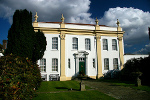
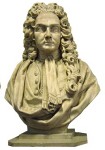 Henry
Raine
(1679-1738) was a wealthy local brewer and devout churchman, born into
a Wapping family of brewers, where he became proprietor of the Star Brewhouse at New Crane Wharf. In 1714 he
built Hurst House [right]
at Woodford in Essex - anticipating the move of many later East Enders
who made good! - which was also known as 'The Naked Beauty' because of
one of its statues. (It was here that Sir Winston Churchill, the local
MP, heard of the peacetime sinking of Thetis in
July 1939. Its current owners are keen to record Raine's life and links with the house.)
Henry
Raine
(1679-1738) was a wealthy local brewer and devout churchman, born into
a Wapping family of brewers, where he became proprietor of the Star Brewhouse at New Crane Wharf. In 1714 he
built Hurst House [right]
at Woodford in Essex - anticipating the move of many later East Enders
who made good! - which was also known as 'The Naked Beauty' because of
one of its statues. (It was here that Sir Winston Churchill, the local
MP, heard of the peacetime sinking of Thetis in
July 1939. Its current owners are keen to record Raine's life and links with the house.)
On
13 August 1725 he married Sarah Petre, daughter of a sea captain from
Mile End New Town. She died on 26 February the following year, and was
buried in the churchyard of St George-in-the-East (he was closely
involved with the founding of the parish) even though the church was
not yet complete. He never remarried; when he died, he was buried near
her - see below for his memorial.
 In 1719 Henry Raine
re-organised a charity school (founded three years earlier in Fawdon
Fields) to provide education for 50 boys and 50 girls from the
neighbourhood of Wapping-Stepney, with a resident master and mistress,
in Charles Street off Old Gravel Lane [now Raine Street, off Wapping
Lane] - an area which at that time was within the parish of St
George-in-the-East. His money was supplemented by
donations and charity sermons. He wrote rules for pupils and staff - of
which the parish holds a copy.
In 1719 Henry Raine
re-organised a charity school (founded three years earlier in Fawdon
Fields) to provide education for 50 boys and 50 girls from the
neighbourhood of Wapping-Stepney, with a resident master and mistress,
in Charles Street off Old Gravel Lane [now Raine Street, off Wapping
Lane] - an area which at that time was within the parish of St
George-in-the-East. His money was supplemented by
donations and charity sermons. He wrote rules for pupils and staff - of
which the parish holds a copy. 


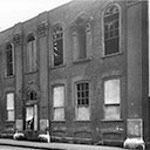
 The building still stands - the stone over the door bears the school
motto (above) and the date, and in niches on either side are statues of
a boy and a girl in the school uniform [right]. These are copies; the originals
moved with the school when it moved elsewhere, and are now preserved
inside the current school premises. The building has been used for many
purposes since the school left; for a time, St Peter's Church next door
used it as a base for work with men and boys, funded by Radley College
- one of the clergy held the title of Radley College Missioner. It is
pictured below in a state of dereliction in 1949, but now, as Raine
House, it is a community centre, and also houses the offices of the Academy of St Martin in the Fields.
The building still stands - the stone over the door bears the school
motto (above) and the date, and in niches on either side are statues of
a boy and a girl in the school uniform [right]. These are copies; the originals
moved with the school when it moved elsewhere, and are now preserved
inside the current school premises. The building has been used for many
purposes since the school left; for a time, St Peter's Church next door
used it as a base for work with men and boys, funded by Radley College
- one of the clergy held the title of Radley College Missioner. It is
pictured below in a state of dereliction in 1949, but now, as Raine
House, it is a community centre, and also houses the offices of the Academy of St Martin in the Fields.  In
1736 Raine's
Asylum,
or Hospital [left], was
established nearby as a boarding school for 40
girls, selected after two years education at the charity, or
lower, school and trained by a matron for four years for domestic
service. (Lesley O'Connell Edwards, 'Teaching the Poor to Knit' in Knitting Traditions
(2013), records that the mistress was paid £20 a year to teach
knitting, sewing, reading 'and the like', and that the older girls were
expected to earn the salaries of the mistress and cook with their
sewing and needlework.) The Asylum was endowed with freehold
lands in Blackfriars and Castle Street, Stepney and stock from the
South Sea Company; this was to provide for the board and clothing of
the girls, together with £210 annually for two marriage
portions
and two
wedding festivals (see below). William Simpson, first Rector of St George-in-the-East, was appointed Chairman or Treasurer of the Trustees
(46 of them!)
who were incorporated by an Act of 1780, with much
complicated
documentation. By then, the area was changing rapidly and becoming
increasingly populous;
the construction of London Dock in 1802 forced the Asylum to sell large
amounts of freehold property. At the same time many of the schools'
patrons were moving away from the area. In 1816 they affiliated to the newly-formed National Society. The Revd R. Tanaylon was the 'minister' in 1818. As the 1816 Report of the Select Committee on the Education of the Lower Orders in the Metropolis (Minutes of Evidence, p84) and the 1819 Report from Commissioners: Charities in England for Education of the Poor
(Appendix to the First Report p305) show, there were problems. In the
latter report one of the Trustees, Matthew Moody gave evidence, confirmed as true by John Verrall, master of Raine's for 35 years, to
this effect (full evidence here):
In
1736 Raine's
Asylum,
or Hospital [left], was
established nearby as a boarding school for 40
girls, selected after two years education at the charity, or
lower, school and trained by a matron for four years for domestic
service. (Lesley O'Connell Edwards, 'Teaching the Poor to Knit' in Knitting Traditions
(2013), records that the mistress was paid £20 a year to teach
knitting, sewing, reading 'and the like', and that the older girls were
expected to earn the salaries of the mistress and cook with their
sewing and needlework.) The Asylum was endowed with freehold
lands in Blackfriars and Castle Street, Stepney and stock from the
South Sea Company; this was to provide for the board and clothing of
the girls, together with £210 annually for two marriage
portions
and two
wedding festivals (see below). William Simpson, first Rector of St George-in-the-East, was appointed Chairman or Treasurer of the Trustees
(46 of them!)
who were incorporated by an Act of 1780, with much
complicated
documentation. By then, the area was changing rapidly and becoming
increasingly populous;
the construction of London Dock in 1802 forced the Asylum to sell large
amounts of freehold property. At the same time many of the schools'
patrons were moving away from the area. In 1816 they affiliated to the newly-formed National Society. The Revd R. Tanaylon was the 'minister' in 1818. As the 1816 Report of the Select Committee on the Education of the Lower Orders in the Metropolis (Minutes of Evidence, p84) and the 1819 Report from Commissioners: Charities in England for Education of the Poor
(Appendix to the First Report p305) show, there were problems. In the
latter report one of the Trustees, Matthew Moody gave evidence, confirmed as true by John Verrall, master of Raine's for 35 years, to
this effect (full evidence here):
| Is your income at present equal to your expenditure?—I believe it is;
but it would not be sufficient if it were not for the occasional
falling in of the marriage portions [see below]. In what state of repair are the school buildings?—They-are in very bad repair; less than £1,500 would not suffice for the repairs. On the ist May 1817, a voluntary subscription was entered into by the trustees towards a repairing fund, which now amounts to the sum of £179. 8s. 6d. vested in the long annuities, to accumulate until it amounts to £1,000, and never to be reduced below £500. This stock is in the names of the Rev. Robert Farington, D. D. rector, Christian Splidt, Matthew Moody, and William Sharp Handasyde, Esquires. I fear we must sell out part of our stocks, which must lead to a reduction ot our establishment. Are you led to any greater expenses of repair, by the union of the national school with yours?—I think not. |
In the event, a new building was erected at the rear of the Asylum in 1820, and St George's National School was founded within the site of Raine's schools, to plans of 1856 by Andrew Wilson of Cannon Street Road [held at the London Metropolitan Archives]. From 1780 there had been St George's Scholars within the boys school and close links were maintained with the parish branch of the National Society, in association with the Middlesex Schools Society. This school amalgamated with the boys school in 1877.
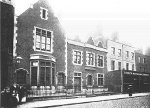
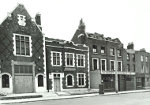
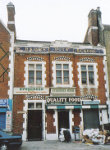
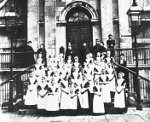

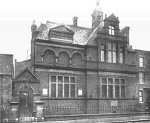 Under
the 1870 Education
Act
the state took up the running
of elementary education; so the Trustees (whose duty was to
provide free education unavailable elsewhere)
decided to raise and extend the education given by the foundation.
Because the Docks had separated the schools from the parish,
the boys
school moved in 1875 to 125 Cannon Street Road [left, then - note the 'School of Cookery' sign - see here for this site's later use as a Jewish boys' club - in 1971 and today], and the girls school
moved in 1885 to the site of the former chapel across the road [right - plus the site as shown on Goad's 1899 insurance map; also a group of boarders on the church steps in 1875]. See here for Rector Harry Jones' 1875 comments on the Foundation. The Corporation of Governors
and
Trustees of Raine's
Charities was dissolved and a new governing body, served by a
Clerk, was created to administer the Foundation in 1880; the Asylum was
closed in 1883. A few years later, the schools became
secondary
schools - boys in 1897,
girls in 1904, to create a 'dual secondary school' from 1904-1913.
The endowments now maintained 100 free scholarships focused on
technical training, with close links to
the London Technical Institute's City and Guilds College. From 1877 to
1904 there was also a preparatory school.
Under
the 1870 Education
Act
the state took up the running
of elementary education; so the Trustees (whose duty was to
provide free education unavailable elsewhere)
decided to raise and extend the education given by the foundation.
Because the Docks had separated the schools from the parish,
the boys
school moved in 1875 to 125 Cannon Street Road [left, then - note the 'School of Cookery' sign - see here for this site's later use as a Jewish boys' club - in 1971 and today], and the girls school
moved in 1885 to the site of the former chapel across the road [right - plus the site as shown on Goad's 1899 insurance map; also a group of boarders on the church steps in 1875]. See here for Rector Harry Jones' 1875 comments on the Foundation. The Corporation of Governors
and
Trustees of Raine's
Charities was dissolved and a new governing body, served by a
Clerk, was created to administer the Foundation in 1880; the Asylum was
closed in 1883. A few years later, the schools became
secondary
schools - boys in 1897,
girls in 1904, to create a 'dual secondary school' from 1904-1913.
The endowments now maintained 100 free scholarships focused on
technical training, with close links to
the London Technical Institute's City and Guilds College. From 1877 to
1904 there was also a preparatory school.

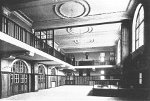




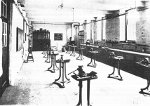
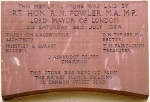 The
school
buildings soon proved inadequate and were condemned by the London
County Council. Faced with
losing its funding, the school opted to move again, to
Arbour Square, Stepney (1911-1913) where a new state-of-the-art building was designed by
H.O.
Ellis [left are the exterior, hall, girls' dining room, art room, gymnasium, chemical laboratory and metalwork room; right is the plaque from Cannon Street Road transferred to Arbour Square]. The schools now functioned as separate entities. Wartime
evacuation took the boys school to Varndean School, Brighton in
1939, the Junior School to Egham in Surrey, the
Senior School
to
Camberley in 1940, and the girls school to Hurstpierpoint in
Sussex.
The
school
buildings soon proved inadequate and were condemned by the London
County Council. Faced with
losing its funding, the school opted to move again, to
Arbour Square, Stepney (1911-1913) where a new state-of-the-art building was designed by
H.O.
Ellis [left are the exterior, hall, girls' dining room, art room, gymnasium, chemical laboratory and metalwork room; right is the plaque from Cannon Street Road transferred to Arbour Square]. The schools now functioned as separate entities. Wartime
evacuation took the boys school to Varndean School, Brighton in
1939, the Junior School to Egham in Surrey, the
Senior School
to
Camberley in 1940, and the girls school to Hurstpierpoint in
Sussex.
With
the re-structuring of the 1944
Education Act the schools
became voluntary aided grammar schools, and
in 1964 co-educational, as Raine's
Foundation School.
In 1976 the Upper School merged with St Jude's Church of
England
Secondary School and moved to Approach Road, Bethnal Green (buildings
of the former Parmiter's School). The Lower School is
now at Old Bethnal Green Road.
Raine Memorial and Founder's Day

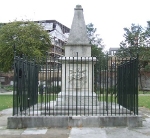
 The texts on the memorial in the churchyard [left] are:
to Raines himself on the western face, to his wife on the northern
face, to other relatives on the eastern face and his coat of arms on
the southern face [right]. As
part of the recent restoration of the Gardens, it was painstakingly
restored, with various grants including a contribution from the Old Raineans' Association
whose site describes the process in more detail. It was carefully
dismantled, and the spalled ferrous fixings replaced with stainless
steel. A time capsule was buried, with copies of The Guardian and Daily Star,
business cards and images of the project team, and appropriately a
bottle of beer. New railings were added - correctly painted, like other
metalwork on site, in dark green: black paint was little-used at that time because they could not get it to dry properly.
The texts on the memorial in the churchyard [left] are:
to Raines himself on the western face, to his wife on the northern
face, to other relatives on the eastern face and his coat of arms on
the southern face [right]. As
part of the recent restoration of the Gardens, it was painstakingly
restored, with various grants including a contribution from the Old Raineans' Association
whose site describes the process in more detail. It was carefully
dismantled, and the spalled ferrous fixings replaced with stainless
steel. A time capsule was buried, with copies of The Guardian and Daily Star,
business cards and images of the project team, and appropriately a
bottle of beer. New railings were added - correctly painted, like other
metalwork on site, in dark green: black paint was little-used at that time because they could not get it to dry properly.
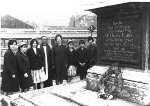
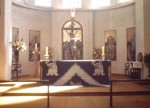
 The
school returns to St George's each year on the first Friday in May
for a Founder's Day service,
when a blue and white wreath is laid at the memorial in St George's
Gardens. Pictured are services from Fr Solomon's time, the school
frontal for the 1978 service [courtesy of David Ward] and from 2003,
with Jack Moore and Stephanie
Smythe dressed in the 18th century school uniforms (the clergy are
Irena Edgecumbe, school chaplain at the time, and Canon John Cullen of
St George's). In 2011 The Old Raineans held their annual reunion at the
church.
The
school returns to St George's each year on the first Friday in May
for a Founder's Day service,
when a blue and white wreath is laid at the memorial in St George's
Gardens. Pictured are services from Fr Solomon's time, the school
frontal for the 1978 service [courtesy of David Ward] and from 2003,
with Jack Moore and Stephanie
Smythe dressed in the 18th century school uniforms (the clergy are
Irena Edgecumbe, school chaplain at the time, and Canon John Cullen of
St George's). In 2011 The Old Raineans held their annual reunion at the
church.
Further historical details about Henry Raine and his schools can be found here. See also C.M. Rose Raine's Foundation: an East End Charity School 1716-80 (University of Bristol thesis 1985), Tony Fuller Henry Raine, Brewer of Wapping (2001), Raine's Prospect 1719-1969 (Raine's Foundation 1969), Raine's Foundation: Its Origins and History (1914), and the comprehensive Henry Raine and the History of Raine's Schools (edited by Alan Johnson for the Old Raineans, 2004).
TMARRIAGE PORTIONS - THE 'HUNDRED POUND SCHOOL'
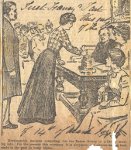
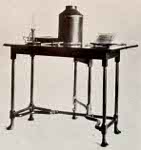
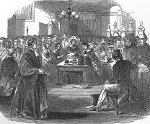
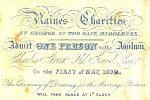 In
his will, Henry Raine provided for two marriage
portions of
£100 to be drawn by lot each
year for
girls aged 22 and above who could produce certificates
of good character from former masters and mistresses, and whose
husbands were suitable members of the Church of England from the
parishes of St George-in-the East, St Paul Shadwell, and St John of
Wapping. He specified that six
small tickets or pieces of paper of equal size should be rolled and
sealed up, in one of which should be written "the sum of one hundred
pounds", the other five to be blank, and being all put into a tin
canister for the draw - the school still has the canister [pictured].
In
his will, Henry Raine provided for two marriage
portions of
£100 to be drawn by lot each
year for
girls aged 22 and above who could produce certificates
of good character from former masters and mistresses, and whose
husbands were suitable members of the Church of England from the
parishes of St George-in-the East, St Paul Shadwell, and St John of
Wapping. He specified that six
small tickets or pieces of paper of equal size should be rolled and
sealed up, in one of which should be written "the sum of one hundred
pounds", the other five to be blank, and being all put into a tin
canister for the draw - the school still has the canister [pictured].
The
weddings
and the draws for the next portion took
place
on 1 May and 26 December (later 5 November); the school marched in
procession to the
church, a breakfast was provided for the bridal party, the girls sang odes traditional to the
occasion, and the trustees and
other notables attended a dinner at which subscriptions were
solicited. The tradition continued until
1892, though by then
the number of applicants was much-reduced.
The marriage registers of St George-in-the-East include this note against the entry for the wedding of Warren Prickett and Mary Downey on 1 May 1806:
| This woman was educated in Mr Raine's Asylum, and drew, and received the Marriage Portion of £100. At the time of her marriage she was far advanced in Pregnancy, for she was delivered of a male child on the 19th of July following. In the Baptism Register - 19th September 1806, on which day the child was christened. A shameful fraud was artfully practised on the Trustees. |
The Sunday Times of 10 November 1844 records a more typical instance:
| NOVEL WEDDING On Tuesday forenoon a marriage took place at the parish church of St. George's-in-the-East, Cannon street, which attracted much curiosity and caused a large concourse of people to assemble. The bride was Jane Macormake, an exceedingly pretty girl, who belonged to Rains's £100 School [sic], and the bridegroom, WIlliam Chinery, a smart young fellow belonging to the Wellclose Square division of the fire brigade. Of the numerous institutions with which the "great metropolis" abounds, there are few from which more positive benefits are disseminated than that of Rains's, near Old Gravel Lane, in the parish of St. George's-in-the-East. The benevolent donor by his will left a sufficient sum of money to support forty girls, to be elected from the parochial schools, for four year. At the end of that period they are sent out to service, and upon attaining the age of nineteen, and their characters being ... [illegible] ... husband. Two marriages take place in every year, namely, one upon the merry 1st of May, or Sweeps' Day, and the other on the 5th of November, or Guy Fawkes' Day; and on the morning of each of those days a drawing takes place for the 1st of May or the 5th of November, as the case may be, and Jane Macormake having drawn the prize on the 1st of May last, was, of course, the next for preferment. When the lucky ticket is drawn, the next thing to be done by its fortunate owner is to look out for an eligible partner (not a Roman Catholic, for they, according to the will of the testator, are ineligible) in the parishes of St. George's-in-the-East, St. Paul, Shadwell, or St. John of Wapping, and this being done a notice is given to the trustees for their approval. In this instance, Jane Macormake's choice fell upon the "waterman fireman", and the trustees having no reason to find fault with his good looks or fair fame, nothing was left but to go through the happy ceremony. In the evening, according to the usual custom, a dinner took place at the institution, at which the bride, the bridegroom, and several of their party attended, and after the health of the happy couple was given, the chairman presented the bridegroom with 100 new sovereigns, in a bag, as the bridal portion from the institution. |
For
more details
see this
.pdf extract from William Quekett's My Sayings and Doings
which provides the
music for the ceremony, written at his request by the Revd Dr Henry Gauntlett
(1805-76); and here for Harry Jones' 1875 description of the ritual, and call for its reform.